Traumatic Brain Injury and Opioid Use Toolkit
***This toolkit is a work in progress***

I. OVERVIEW OF THE TOOLKIT
The toolkit is divided into five sections:
1) Patient and Family Resources: Among other resources in this section, the reader will find a checklist for possible risk factors for opioid misuse for people with TBI, although it should be noted that this checklist is based only on expert opinion, and has not been validated. Also included is a Patient Transfer Handout that should be given to all of the patient’s health care providers to ensure that all of the health care providers are aware of the patient’s history of TBI and potential implications for prescribing pain medications.
2) Provider Resources: One of the most essential components in this section is the Ohio State University Traumatic Brain Injury Identification Method (OSU-TBI-ID). This screening tool was developed to help providers identify when the patient has a lifetime history of TBI. Included in this section are links to websites where providers can receive training on how to administer and score the OSU-TBI-ID. Also included in this section is our Opioid Prescribing Recommendations for People with TBI (section ix). Providers should also note that section XV provides an infographic that can be posted at a variety of locations to promote awareness of the risk of TBI and opioid overdose.
3) TBI and Opioid Use Webinars Slides and Videos: These downloadable resources can be used for training all interested stakeholders. It should also be noted that these webinars have free CME’s.
4) Repository of Resources from Outside Agencies: This section contains many resources related to TBI and opioid use/misuse.
5) Repository of Primary Literature: Very little has been published to date on TBI as a risk factor for opioid misuse, but available articles central to these issues are included herein.
II. WHY IS THIS TOOLKIT IMPORTANT?
The impact of the opioid epidemic is well-known. It was estimated in 2013 that 1.9 million people misused or were dependent on prescription opioid pain medications (1). Additionally, more than 165,000 individuals died of overdose-related to opioid pain medication in the United States from 1999 to 2014 (2). Unknown until quite recently is that people with a history of traumatic brain injury (TBI) may be as high as 11 times more likely to die from accidental fatal poisoning as compared to the general population, with opioids the attributed cause in a significant proportion of cases (3). The overriding goals of this toolkit are, therefore, to promote awareness of this risk, and to give people with TBI, their families and caregivers, and provides tools to prevent opioid overdose.
Introduction to Traumatic Brain Injury (TBI) and Its Relationship to Opioid Misuse
 Epidemiology
Epidemiology
According to the Centers for Disease Control and Prevention (CDC), TBI contributes to more than 30% of all injury-related fatalities within the United States. The CDC goes further by estimating that TBI contributes to around 50,000 deaths annually across the United States. In the most recent TBI report, the CDC noted a 47% increase in national TBI-related ED visits over six years (4). The CDC further reports that there are about 2.5 million TBI-related ED visits within the United States annually. The CDC estimates that approximately 80,000 to 90,000 people in the United States each year will have a TBI that results in lifelong disability and that 5.3 million people are living with chronic impairment related to TBI (5).
Severity of TBI and TBI Disability
The CDC defines TBI as a disruption in the normal function of the brain that can be caused by a bump, blow, or jolt to the head or penetrating head injury. From this event, one of the following must be present, including the decreased level of consciousness, amnesia, neuropsychological or neurological impairment, an intracranial lesion on imaging, skull fracture, or death caused by head injury (6) (7) (8). In 2013, there were 2.8 million people who had a TBI in the United States who were seen in an emergency department, hospitalized or died (9). The severity of TBI ranges from mild (also referred to as a concussion) to severe and may result in only transient symptoms to long-lasting impairments, persistent vegetative state, or death. It should be noted that the acute severity of TBI may not predict long term levels of TBI-related disability, as some single mild TBIs may be associated with chronic impairments and disability, while some with severe TBI may recover well without a noted disability. Corrigan and colleagues have recently suggested that TBI assessment should address lifetime exposure to TBI, taking into account the history of multiple TBIs and the potential delayed effects of TBI (10).
Exceptionally moderate to severe or repetitive mild TBI frequently results in chronic disability (11). Further, the level of disability that follows from TBI is not static, with a change in level and type of disability more common than stability. More specifically, it was found in a fifteen-year follow-up study of the National Institute of Disability Independent Living and Rehabilitation Research Traumatic Brain Injury Model Systems that while 30% of patients improve to have less disability from one follow-up epoch to another, 30% become more disabled, and only about 40% remain stable (12). This dynamic variability results from a host of biopsychosocial factors, including new-onset or resolution of psychiatric or other medical co-morbidities, loss of environmental supports, or aging, as examples.
 Substance Abuse and TBI
Substance Abuse and TBI
TBI and substance abuse share an unfortunate bi-directional relationship: substance abuse is a risk for TBI and TBI is a risk for substance abuse. Studies have demonstrated that between 36-51% of people admitted to a hospital with a TBI test positive for blood alcohol and 25% to 68% of those with TBI have a history of alcohol dependence (13). Corrigan and colleagues have found that 58% to 66% of people with TBI had a history of alcohol misuse pre-injury (14), and 40% to 55% misused other illicit substances pre-TBI (15). Further, childhood TBI increases the risk of adolescent and adult alcohol misuse from 54% relative to those without TBI, as compared to 31% for those without childhood TBI. Childhood TBI also increased misuse of illicit drugs to 54% as compared to 20% for the non-TBI sample (16).
Post-TBI substance abuse is not uncommon, and the risk increases as does time since injury. For the first two years, post-TBI substance misuse is uncommon, but by five years post-injury, 25% were found to have clinically significant substance misuse, both alcohol and illicit drugs (17). It should also be noted that in a study of people with co-occurring mental health and substance abuse disorders, 80% screened positive for lifetime exposure to TBI, and 25% reported at least one moderate or severe TBI (18).
 Pain and TBI
Pain and TBI
Headache is common after TBI and between 40% and 50% of patients, regardless of whether they were mild, moderate, or severe TBI’s (19). There is an apparent inverse correlation in regards to the severity of pain and severity of TBI, with mild TBI showing about a 75% rate of pain, while moderate to severe TBI showed close to 32% (20). While headache is the most frequent source of pain following TBI, the mechanism through which people receive TBI also frequently results in bodily injury. In a systematic review of research on different types of chronic pain, it was found that of those with TBI admitted to an inpatient rehabilitation unit, 12% developed complex regional pain syndrome, 11 percent developed painful heterotopic ossification, and 10 percent had neuropathic pain. Overall, it was found that 51.5 percent of patients with TBI developed some type of chronic pain (20). Consequently, people with acute TBI are frequently started on a narcotic analgesic. In a multi-center study, it was found that over 70% of people with TBI were prescribed opioids during their hospitalization (21).
Clinical Course of TBI and Opioid Misuse
The research suggests that a significant percentage of people with opioid use disorder may have a lifetime exposure to TBI, sometimes characterized by multiple TBI’s. A cascade of possible causal factors may lead to opioid overdose and death, starting with childhood TBI, which is a significant risk for adolescent and adult substance abuse disorder. Consequences of substance abuse, such as motor vehicle crashes and falls, can result in TBI. TBI often results in pain, and the injury may have also resulted in other orthopedic sources of pain. As a consequence, many people with acute TBI are prescribed opioids. It may also be the case that people years after TBI have started on opioids for pain resulting from another source than TBI, but the prescribing physician has no knowledge of the preexisting TBI. TBI is known to result in impairments of judgment, impaired behavioral and emotional regulation, such as impulsivity (22) and affect neural networks that control stimulus-reward associations (23). These cognitive and neurobehavioral impairments may, therefore, increase the probability of, at least in part, unintentional substance misuse and overdose, especially for those with a pre-TBI history of substance abuse.
Hypoxic Encephalopathy and Overdose
Overdose on opioids on opioids can suppress the respiratory system, resulting in a partial deprivation of oxygen to the brain (hypoxia) or complete deprivation of oxygen to the brain (anoxia), which can result in variable levels of brain damage, ranging from transient cognitive impairment to death. How complete the oxygen deprivation and the duration determines the severity of brain damage (24). Administration of an opioid antagonist will restore respiratory function, but cannot reverse the brain damage that may have resulted. The effects of hypoxic or anoxic encephalopathy can be very similar to the cognitive and behavioral effects of TBI, including impairments of memory, attention and concentration, and impaired executive functions, including impaired self-awareness, poor behavioral and emotional self-regulation. In the person who has already had a TBI, subsequent overdose induced hypoxic and/ anoxic encephalopathy can, therefore, exacerbate the cognitive and behavioral impairments that were already present.
What to do when you think your risk or someone’s risk might be high?
1) Consult your physician as soon as possible.
2) Educate health care providers about TBI as a risk factor for overdose – use the infographic provided in this toolkit and give out the website for this toolkit.
3) If you are not sure about a history of TBI or its effects, consult with your physician and consider seeing a Physical Medicine and Rehabilitation Physician (Physiatrist) and/or a Neuropsychologist that specializes in TBI.
4) Call SAMHSA’s National Helpline, 1-800-662-HELP (4357) or TTY: 1-800-4874889, which is a confidential, free, 24-hour-a-day, 365-day-a-year, information service, in English and Spanish, for individuals and family members facing mental and/or substance use disorders. This service provides referrals to local treatment facilities, support groups, and community-based organizations. Callers can also order free publications and other information.
RESOURCES
Patient & Family
I. E-Book: Prescribing Opioids for TBI Patients
II. Brain Injury and Opioid Overdose Infographic
III. VA Opioid and TBI Recommendations
V. Available Local Accommodations
VI. Repository of Resources from Outside Agencies
VIII. Alternative Pain Management Strategies
IX. TBI Documentary Videos
X. Outpatient Opioid De-escalation Recommendations
XI. Local Accommodations list
Provider
I. E-Book: Prescribing Opioids for TBI Patients
II. IDOH TBI State Plan 
III. Repository of Primary Literature
IV. Veteran Affairs Opioid and TBI Recommendations
V. Patient Risk-Factor Checklist
VI. Monitoring Tools for Assessing Substance Abuse Risk in TBI patients
VII. Cultural Competency Training
VIII. TBI & Opioid Use Webinars (See Introduction to TBI and Its Relationship to Opioid Misuse)
IX. Screening for Lifetime Exposure to TBI
X. How to Accommodate the Effects of TBI
XI. Opioid Prescribing Recommendations for People with TBI
XII. Inpatient Opioid De-escalation Strategies
XIII. Alternative Pain Management Recommendations (Post-release)
XIV. Non-opioid Pain Management Strategies during Acute Care
XV. State & National Legislation Lookup for TBI and Opioid Policy
XVI. Indiana Accommodations list
XVII. Brain Injury and Opioid Overdose Infographic
TBI & Opioid Use Webinars Slides & Videos
II. TBI Risk Factors
III. Opioids Prescribing Recommendations for People with TBI
IV. Education and Resources for Individuals with TBI
V. Screening
Repository of Resources from Outside Agencies
AMA - Co-prescribe naloxone to patients at risk of overdose 
APA – Diagnostic Criteria for Opioid Use Disorder
CDC – Interactive Training On Opioid Prescribing
CDC – Clinical Outreach and Communication Webinar Series
CDC – Assessing Benefits and Harms of Opioid Prescribing
CDC- Guidelines for Prescribing Opioids For Chronic Pain
CDC – Acute Pain and Opioid Infographic 
CDC- Rx Awareness Campaign Toolkit Opioids
CDC – Opioid Prescribing Infographic
CDC – Opioid Prescribing Guidelines (Formal)
CDC – Managing Your Pain: Which is Right for You? 
CDC- Urine Drug Testing of Opioids
CDC - Informational Materials and Resources to Prevent Addiction Related to Youth Sports Injuries
DoD – Mild Traumatic Brain Injury (Concussion) Rehabilitation Toolkit
HHS - General Principles for Evaluating the Abuse Deterrence of Generic Solid Oral Opioid Drug Products
Indiana Law Regarding Opioid Prescribing
INROADS Project - Intersection Between Traumatic Brain Injury And Opioid Use Disorder
IDOH – Comparison of Opioid Prescribing Rules: CDC vs. Indiana
IDOH – Indiana Guidelines for the Management of Acute Pain
IUSM - Pain Management in Indiana
MBIA - The Opioid Crisis and Brain Injury PowerPoint
MHHA - Inpatient Opioid Misuse Prevention Guidelines 
NASHIA - Brain Injury and Opioid Overdose
NIH - eBook on Pain Complementary Approaches
NIH - National Pain Strategy 
NIH - Abuse-Deterrent Opioids - Evaluation and Labeling
ODFR- Overdose Fatality Review through a Brain Injury Informed Lens
Repository of Primary Literature
Achamallah et al - Toxic Leukocephalopathy Mimics Anoxia Brain Injury
Corrigan - The Intersection of Lifetime History of Traumatic Brain Injury and the Opioid Epidemic
Corrigan et al - Screening and Brief Intervention for Substance Misuse Among Patients with TBI
Cottler et al - TBI and Opioid Misuse in Professional Athletes
Hammond - Psychotropic medications in Inpatient Rehabilitation
Marino et al -Posttraumatic TBI Pain Management
Nampiaparampil - Prevalence of Chronic Pain after TBI
Padilla-Jones - Inpatient and Outpatient Pain Protocol
Ripley et al - Pharmacologic Management of the Patient with TBI
Shaw et al - AAPMR Position Statement
Tolomeo et al – Multifaceted Impairments In Impulsivity and Brain Structural Abnormalities In Opioid Dependence and Abstinence
“Brain Injury Association of American Position Statement on TBI and Opioids"
AUTHORS AND ACKNOWLEDGEMENT
Katie Hokanson – Katie Hokanson is the Director of the Division of Trauma and Injury Prevention at the Indiana Department of Health (IDOH). During her time as Director, Katie has been the driving factor in developing materials and collaborating with organizations to build the statewide TBI infrastructure.
Dr. Lance Trexler – Dr. Lance Trexler director of the Department of Rehabilitation Neuropsychology at the Rehabilitation Hospital of Indiana, adjunct clinical assistant professor of PM&R at the Indiana University School of Medicine, adjunct assistant professor of Speech and Hearing Sciences at Indiana University, and adjunct assistant professor of Psychological Sciences at Purdue University. He is also past-chair of the Indiana Spinal Cord and Brain Injury Research Board of Directors and past-chair of the Indiana Brain Injury Association of Indiana. Dr. Trexler has published more than 30 book chapters and peer-reviewed articles and given more than 100 peer-reviewed and invited presentations at professional conferences throughout North American and Europe. Dr. Trexler also continues to provide neuropsychological assessment and rehabilitation services at the Rehabilitation Hospital of Indiana.
Jeremy Funk – Jeremy Funk is a Clinical Epidemiologist at the Rehabilitation Hospital of Indiana. Jeremy was integral in developing Indiana’s first TBI state plan.
Dr. John Corrigan – Dr. John Corrigan is one of the nation’s top TBI researchers and the creator of the TBI Retrospective Survey. Dr. Corrigan is a professor in the Department of Physical Medicine and Rehabilitation at Ohio State University. He also serves as the director of the Ohio Valley Center for Brain Injury Prevention and Rehabilitation.
Dr. Flora Hammond – Dr. Hammond is Project Director of the Indiana Traumatic Brain Injury Model System, and Chair of the TBI Model Systems Program Executive Committee. Dr. Hammond’s research and advocacy focuses on the long-term issues confronting individuals with disability and treatment effectiveness.
Dr. Brandy Padilla-Jones – Dr. Padilla-Jones is a General Surgeon at IU Health Medical Center located in Indianapolis. She is a thought leader in developing best practices for non-opioid pain relief and opioid therapy tapering and discontinuation.
REFERENCES
1. Administration, Substance Abuse and Mental Health Services. Results from the 2013 National Survey on Drug Use and Health: Summary of National Finding 2014. Rockville, MD.
2. Centers for Disease Control and Prevention. Multiple cause of death data. CDCWONDER 2016.
3. Hammond FM, Ketchum JM, Dams-O'Connor K, Corrigan JD, Miller AC, Haarbauer-Krupa J, Faul M, Trexler L, Harrison-Felix C. Mortality secondary to unintentional poisoning after inpatient rehabilitation for traumatic brain injury. In preparation.
4. Centers for Disease Control and Prevention, "Traumatic Brain Injury and Concussion," Atlanta, GA, 2016.
5. Centers for Disease Control and Prevention, "Moderate to Severe Traumatic Brain Injury is a Lifelong Condition (Fact Sheet)," National Center for Injury Prevention and Control; Division of Unintentional Injury Prevention, Atlanta, GA, 2016.
6. Centers for Disease Control and Prevention. Traumatic brain injury in the United States: A report to Congress. Atlanta, GA: U.S. Department of Health and Human Services, 1999.
7. Coronado VG, Haileyesus T, Cheng TA, et al. Trends in traumatic brain injury in the U.S. and the public health response: 1995-2009. J Safety Res 2012; 43(3): 299-307.
8. Marr AL, Coronado VG. Central nervous system injury surveillance data submission standards – 2002. Atlanta, GA: Centers for Disease Control and Prevention, National Center for Injury Prevention and Control 2004.
9. Taylor CA, Bell JM, Breiding MJ, et al. Traumatic brain injury-related emergency department visits, hospitalizations, and deaths - United States, 2007 and 2013. MMWR Surveill Summ 2017; 66(9): 1-16.
10. Corrigan JD, Yang J, Singichetti B, et al. Lifetime prevalence of traumatic brain injury with loss of consciousness. Inj Prev, August 28, 2017.
11. Centers for Disease Control and Prevention. Moderate to severe traumatic brain injury is a lifelong condition [Fact Sheet]. Atlanta, GA: National Center for Injury Prevention and Control; Division of Unintentional Injury Prevention.
12. Corrigan JD, Hammond FM. Traumatic brain injury as a chronic health condition. Arch Phys Med Rehabil 2013; 94(6): 1199-1201.
13. Edna T. Alcohol influence and head injury. Acta Chir Scand, 1985; 209-212.
14. Corrigan JD. Substance abuse as a mediating factor in outcome from traumatic brain injury. Arch Phys Med Rehabil, 1995: 76(40, 302-309.
15. Corrigan JD, Bogner JA, Mysiw WJ et al. Life satisfaction after traumatic brain injury. J Head Trauma Rehabil, 2001: 16(6), 543-555.
16. Corrigan JD, Bogner J, Mellick D, Bushnick T et al. Prior history of traumatic brain injury among persons in the Traumatic Brain Injury Model Systems National Database. Arch Phys Med Rehabil, 2013; 94(10), 1940-1950.
17. Corrigan JD, Smith-Knapp K, Granger CV. Outcomes in the first 5 years after traumatic brain injury. Arch Phys Med Rehabil, 1998; 79:298-305.
18. McHugo GJ, Krassenbaum S, Donley S et al. The prevalence of traumatic brain injury among people with co-occurring mental health and substance use disorders. J Head Trauma Rehabil, 2017; 32(3), E65-E74.
19. Hoffman, J.M, Lucas,S., Dikmen, S., Braden, C.A., Brown, A.W., Brunner, R.,...Bell, K.R. Natural history off headache following traumatic brain injury. J Neurotrauma 2011; 28(9): 1719-1725.
20. Nampiaparampil DE. Prevalence of chronic pain after traumatic brain injury. JAMA 2008; 300(6): 711-19. 21. Hammond FM, Barrett RS, Shea T et al. Psychotropic medication use during inpatient rehabilitation for traumatic brain injury. Arch Phys Med Rehabil, 96 (8), S256-253.
21. Hammond FM, Barrett RS, Shea T et al. Psychotropic medication use during inpatient rehabilitation for traumatic brain injury. Arch Phys Med Rehabil, 96 (8), S256-253.
22. Stuss DT, Levine B. Adult clinical neuropsychology: Lessons from the studies of frontal lobes. Annu Rev Psychol, 2002; 53:401-433.
23. Rolls ET. The orbitofrontal cortex and reward. Cereb Cortex, 2000; 10:284-294.
24. Schirmer D, Seale GS. Non-lethal opioid overdose and acquired brain injury: a position statement of the Brain Injury Association of America. Retrieved from https://www.biausa.org/public-affairs/media/non-lethal-opioid-overdose-acquired-brain-injury. Accessed November 16, 2019.
Page last updated 10/19/2020.

